The Intel Ivy Bridge (Core i7 3770K) Review
by Anand Lal Shimpi & Ryan Smith on April 23, 2012 12:03 PM EST- Posted in
- CPUs
- Intel
- Ivy Bridge
The Test
It turns out that our initial preview numbers were quite good. The shipping 3770K performs identically to what we tested last month. To keep the review length manageable we're presenting a subset of our results here. For all benchmark results and even more comparisons be sure to use our performance comparison tool: Bench.
| Motherboard: | ASUS P8Z68-V Pro (Intel Z68) ASUS Crosshair V Formula (AMD 990FX) Intel DX79SI (Intel X79) Intel DZ77GA-70K (Intel Z77) |
| Hard Disk: | Intel X25-M SSD (80GB) Crucial RealSSD C300 OCZ Agility 3 (240GB) |
| Memory: | 4 x 4GB G.Skill Ripjaws X DDR3-1600 9-9-9-20 |
| Video Card: | ATI Radeon HD 5870 (Windows 7) AMD Processor Graphics Intel Processor Graphics |
| Video Drivers: | AMD Catalyst 12.3 |
| Desktop Resolution: | 1920 x 1200 |
| OS: | Windows 7 x64 |
General Performance
SYSMark 2007 & 2012
Although not the best indication of overall system performance, the SYSMark suites do give us a good idea of lighter workloads than we're used to testing. SYSMark 2007 is a better indication of low thread count performance, although 2012 isn't tremendously better in that regard.
As the SYSMark suites aren't particularly thread heavy, there's little advantage to the 6-core Sandy Bridge E CPUs. The 3770K however manages to slot in above all of the other Sandy Bridge parts at between 5—20% faster than the 2600K. The biggest advantages show up in either the lightly threaded tests or in the FP heavy benchmarks. Given what we know about Ivy's enhancements, this is exactly what we'd expect.
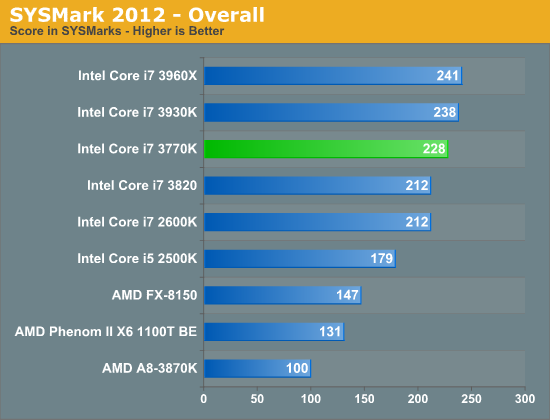
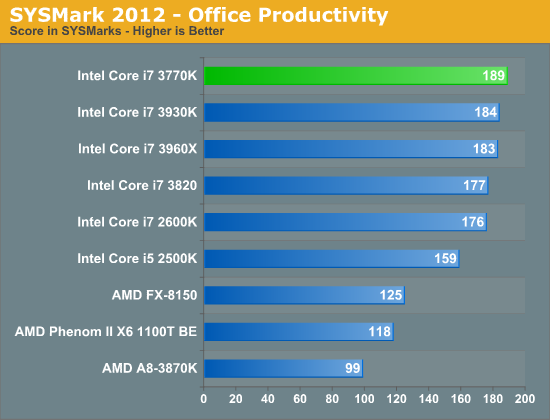

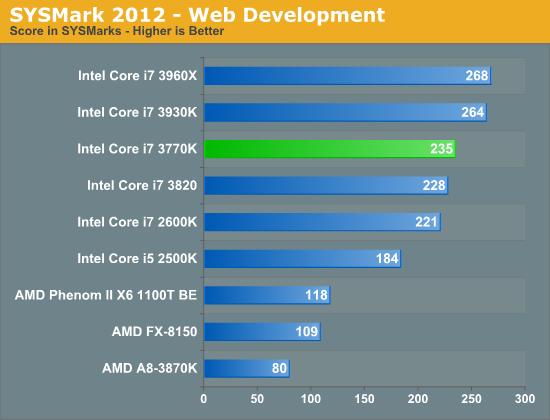
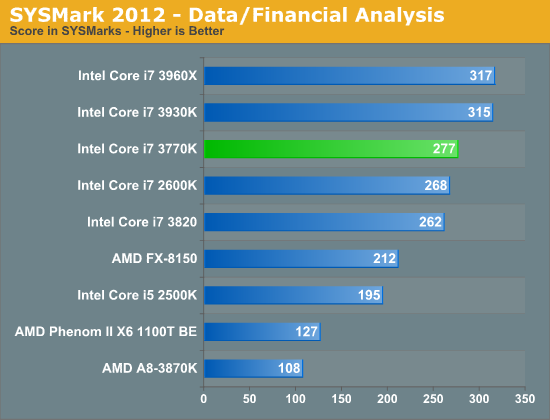
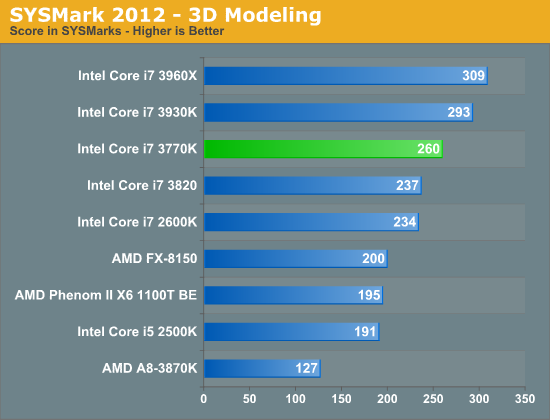


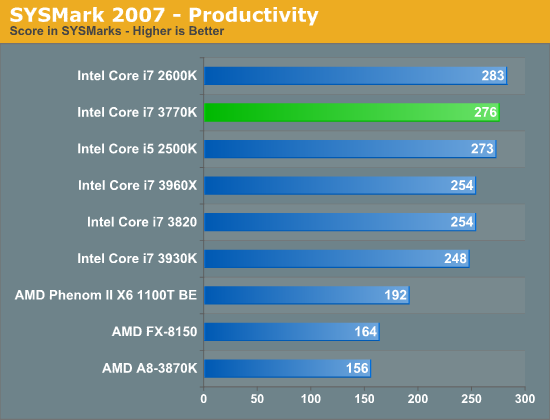
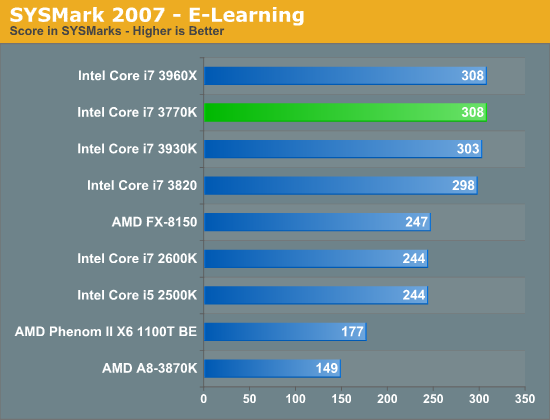
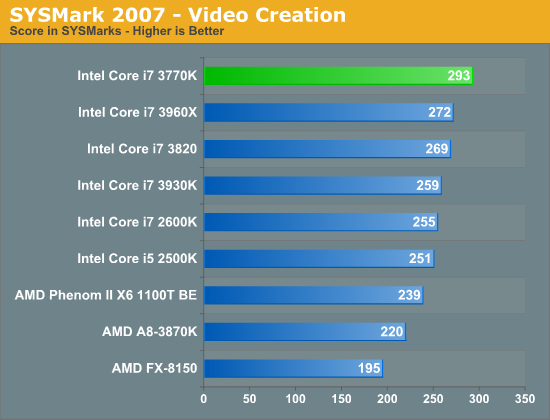

Content Creation Performance
Adobe Photoshop CS4
To measure performance under Photoshop CS4 we turn to the Retouch Artists’ Speed Test. The test does basic photo editing; there are a couple of color space conversions, many layer creations, color curve adjustment, image and canvas size adjustment, unsharp mask, and finally a gaussian blur performed on the entire image.
The whole process is timed and thanks to the use of Intel's X25-M SSD as our test bed hard drive, performance is far more predictable than back when we used to test on mechanical disks.
Time is reported in seconds and the lower numbers mean better performance. The test is multithreaded and can hit all four cores in a quad-core machine.
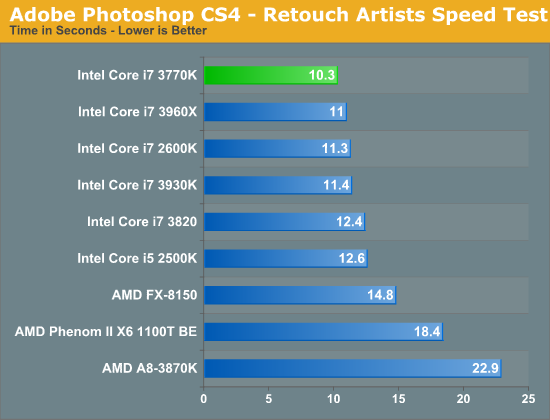
Our Photoshop test is well threaded but it doesn't peg all cores constantly. Instead you get burstier behavior. With the core count advantage out of the way, SNB-E steps aside and allows the 3770K to step up as the fastest CPU we've tested here. The performance advantage over the 2600K is around 9%.
3dsmax 9
Today's desktop processors are more than fast enough to do professional level 3D rendering at home. To look at performance under 3dsmax we ran the SPECapc 3dsmax 8 benchmark (only the CPU rendering tests) under 3dsmax 9 SP1. The results reported are the rendering composite scores.
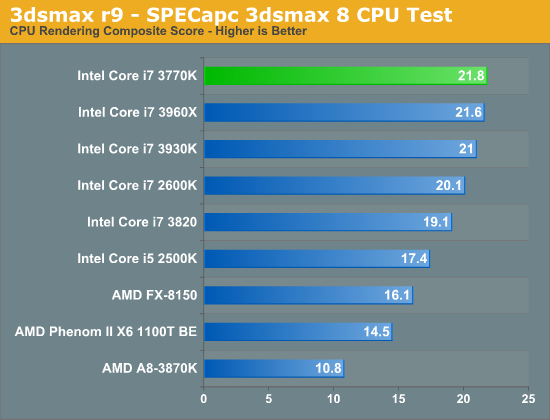
In another FP heavy workload we see a pretty reasonable gain for Ivy Bridge: 8.5% over a 2600K. This isn't enough to make you want to abandon your Sandy Bridge, but it's a good step forward for a tick.
Cinebench 11.5
Created by the Cinema 4D folks we have Cinebench, a popular 3D rendering benchmark that gives us both single and multi-threaded 3D rendering results.
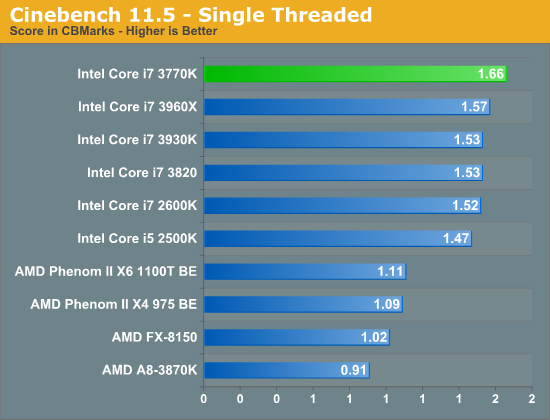
The single threaded Cinebench test shows a 9% performance advantage for the 3770K over the 2600K. The gap increases slightly to 11% as we look at the multithreaded results:
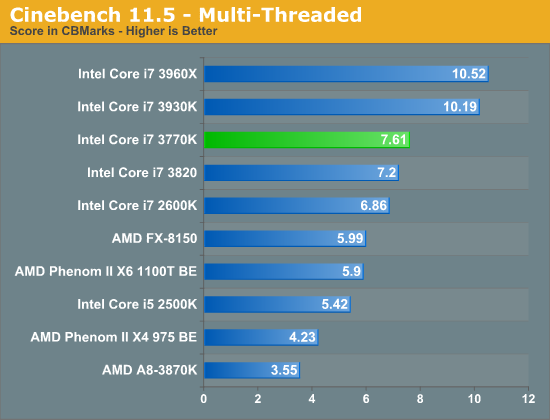
If you're running a workload that can really stress multiple cores, the 6-core Sandy Bridge E parts will remain unstoppable but in the quad-core world, Ivy Bridge leads the pack.
Video Transcoding Performance
x264 HD 3.03 Benchmark
Graysky's x264 HD test uses x264 to encode a 4Mbps 720p MPEG-2 source. The focus here is on quality rather than speed, thus the benchmark uses a 2-pass encode and reports the average frame rate in each pass.

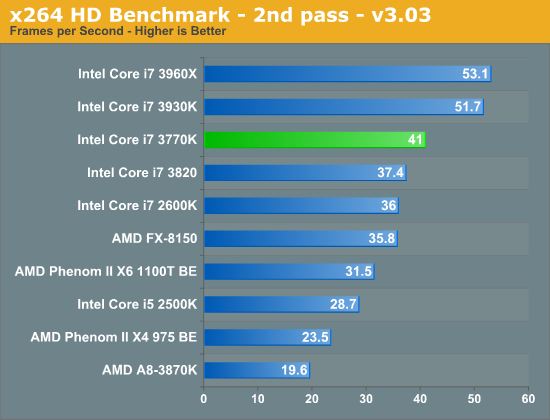
In the second pass of our x264 test we see a nearly 14% increase over the 2600K. Once again, there's no replacement for more cores in these types of workloads but delivering better performance in a lower TDP than last year's quad-core is great for more thermally conscious desktops.
Software Development Performance
Compile Chromium Test
You guys asked for it and finally I have something I feel is a good software build test. Using Visual Studio 2008 I'm compiling Chromium. It's a pretty huge project that takes over forty minutes to compile from the command line on a Core i3 2100. But the results are repeatable and the compile process will stress all 12 threads at 100% for almost the entire time on a 980X so it works for me.
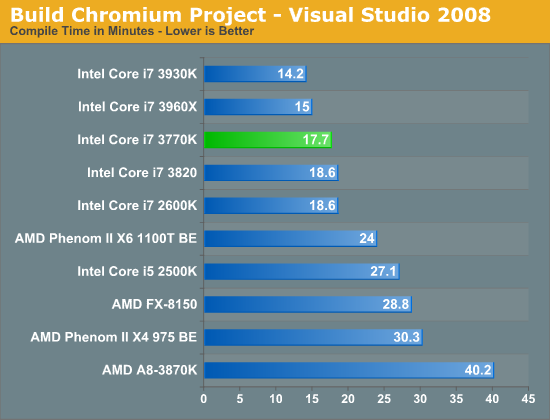
Ivy Bridge shows more traditional gains in our VS2008 benchmark—performance moves forward here by a few percent, but nothing significant. We are seeing a bit of a compressed dynamic range here for this particular compiler workload, it's quite possible that other bottlenecks are beginning to creep in as we get even faster microarchitectures.
Compression & Encryption Performance
7-Zip Benchmark
By working with a small dataset, the 7-zip benchmark gives us an indication of multithreaded integer performance without being IO limited:
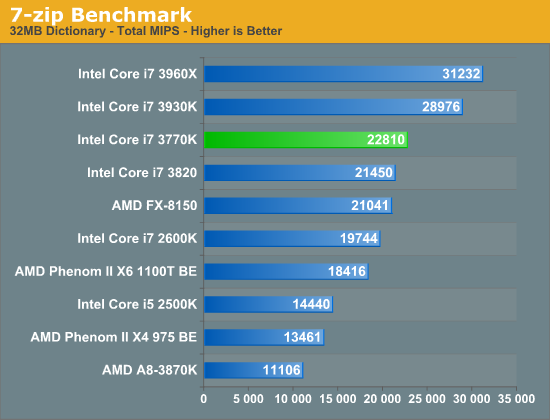
Although real world compression/decompression tests can be heavily influenced by disk IO, the CPU does play a significant role. Here we're showing a 15% increase in performance over the 2600K. In the real world you'd see something much smaller as workloads aren't always so well threaded. The results here do have implications for other heavily compute bound integer workloads however.
TrueCrypt Benchmark
TrueCrypt is a very popular encryption package that offers full AES-NI support. The application also features a built-in encryption benchmark that we can use to measure CPU performance:

Our TrueCrypt test scales fairly well with clock speed, I suspect what we're seeing here might be due in part to Ivy's ability to maintain higher multi-core turbo frequencies despite having similar max turbo frequencies to Sandy Bridge.










173 Comments
View All Comments
bman212121 - Monday, April 23, 2012 - link
Does anyone know which motherboards are going to support VT-d? Is there a specific chipset you'll need to have or will it just be up to the vendor to decide?Thanks,
Bman
Magichands8 - Monday, April 23, 2012 - link
I feel so ambivalent about Intel's current strategy. I admit I really don't understand why laptops are moving ahead so significantly. Why on earth would someone want to buy a laptop to replace a home desktop system? And if they aren't doing that then how can Intel justify a move away from the high performance end of the spectrum? If you really need to do business work away from home AND away from work then I can see the need for the mobility that a laptop can provide but this focus on a gaming-centric platform so that people can one day soon play Crisis on their laptop at traffic stops on the way to work is utterly baffling to me. On the other hand, the process technology and architectural improvements we are seeing are amazing. It just burns me that performance for what I use a desktop for is essentially at a standstill now so that Intel can save this unfathomable laptop crowd a few watts during the occasional vacation. As it stands when I see a review like this at first I'm like "Oh wow!" and then I feel cheated for having waited for Intel's latest and greatest. Ivy Bridge-E and Haswell-E better be mind blowing or I'm going to be completely crestfallen at the direction that Intel is taking.Quantumbytes - Monday, April 23, 2012 - link
Intel is following a strategy that will in the end provide compute power for small and powerfull devices like cell phones, laptops, tablets, RFIDs, food and apparel tags, etc. They are looking at the big picture and the money is in the small designs. Desktops are a means to an end. Get used to the push to small and simple.JarredWalton - Monday, April 23, 2012 - link
Thanks for being an AMD apologist and reading with blinders. Trinity will probably maintain the GPU performance gap. Until Trinity arrives, however, IVB HD 4000 on laptops on average across 15 games is equal to Llano A8 on laptops.And what other things are people doing with graphics besides games? Video transcoding? Okay, there's one task. Name another that computer users do on a regular basis. [Crickets...]
So why is Intel putting so much effort into graphics? Because their business is to sell you a new microprocessor every 2-3 years if they can. With the ability to put 1.4 billion transistors into a 130mm^2 die, what else are they supposed to do? More cache? More CPU cores? You try to make the worst aspect of your product better, and then you market it to the masses. That's all that's really happening here.
frozentundra123456 - Monday, April 23, 2012 - link
Most Llano laptops I have seen are not even the A8 model, but mostly the A6, with somewhat lower graphics capabilities. So I think you are being very fair to AMD in comparing their top of the line graphics to HD4000, instead of the lower performance A6 graphics.André - Monday, April 23, 2012 - link
"Unfortunately at the time only Apple was interested in a hypothetical Ivy Bridge GT3 and rumor has it that Otellini wasn't willing to make a part that only one OEM would buy in large quantities. We will eventually get the GPU that Apple wanted, but it'll be next year, with Haswell GT3. And the GPU that Apple really really wanted? That'll be GT4, with Broadwell in 2014."Can't help but wonder were you got this tidbit from? :-)
Very interesting.
André - Monday, April 23, 2012 - link
D'oh ... spelling.Where you got the tidbit from even.
SC-D_E_A_T_H - Monday, April 23, 2012 - link
I'll be sticking with my AMD Sempron 3400+. A processing badass!DanNeely - Monday, April 23, 2012 - link
"How many enthusiasts who overclock their computers are going to be running them *at full load* 24/7? None. "I do. The 30W difference at stock would be ~$40/year directly (13c/kwh); and probably twice that indirectly since my LL pays for heat during the winter, but the AC bills all mine. Vs my current x58 boxes, probably another factor of 1.5-2x; although unless OC levels creep up over the next few months I'm tempted to just wait and hope haswell doesn't burn all its improvements on the IGP and lower TDP for mobile.
Malih - Monday, April 23, 2012 - link
Somehow I'm no longer hungering for the top performance CPU.CPU performance has somewhat exceed most people daily needs (and mine too), and mobile CPUs are more exciting today, especially if they can help the system to consume less battery and have better graphics. I think its now safe enough for manufacturer like for example Apple to go for Trinity instead of Ivy Bridge for their MB Air, provided Trinity can be made to consume minimal power.